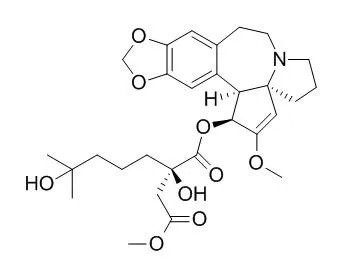| Description: |
Homoharringtonine, a plant alkaloid with antitumor and antileukemic properties, inhibit protein translation by preventing the initial elongation step of protein synthesis via an interaction with the ribosomal A-site. Homoharringtonine might have clinical activity in some patients with myelodysplastic syndrome. |
| Targets: |
Caspase | PARP | Bcl-2/Bax | MEK | ERK |
| In vitro: |
| Am J Hematol. 2004 Jul;76(3):199-204. | | Homoharringtonine mediates myeloid cell apoptosis via upregulation of pro-apoptotic bax and inducing caspase-3-mediated cleavage of poly(ADP-ribose) polymerase (PARP).[Pubmed: 15224352 ] | Homoharringtonine (HHT) is a plant alkaloid with antileukemia activity that is currently being used for treatment of acute, chronic leukemias and MDS.
METHODS AND RESULTS:
In this study, we show that HHT can induce apoptosis in a variety of human myeloid leukemia cell lines (U937, HL-60, HEL, THP, and K562). U937 and HL60 cells undergo rapid apoptosis on treatment with HHT, as indicated by increased annexin V binding capacity, caspase-3 activation, and cleavage of poly(ADP-ribose) polymerase (PARP). In addition, the expression of bax is upregulated during HHT-induced cell death, whereas the expression of bcl-2 is only slightly decreased. Importantly, treatment of primary leukemic cells, obtained from acute myeloid leukemia patients, resulted in rapid apoptosis.
CONCLUSIONS:
Thus, our data provide the mechanism of HHT and justify the use of HHT in the treatment of human myeloid leukemia. | | Sci Rep. 2015 Jul 13;5:8477. | | Homoharringtonine induces apoptosis and inhibits STAT3 via IL-6/JAK1/STAT3 signal pathway in Gefitinib-resistant lung cancer cells.[Pubmed: 26166037] | Tyrosine kinase inhibitors (TKIs) are mostly used in non-small cell lung cancer (NSCLC) treatment. Unfortunately, treatment with Gefitinib for a period of time will result in drug resistance and cause treatment failure in clinic.
METHODS AND RESULTS:
Therefore, exploring novel compounds to overcome this resistance is urgently required. Here we investigated the antitumor effect of Homoharringtonine (HHT), a natural compound extracted from Cephalotaxus harringtonia, on Gefitinib-resistant NSCLC cell lines in vitro and in vivo. NCI-H1975 cells with EGFR T790M mutation are more sensitive to HHT treatment compared with that of A549 cells with wild type EGFR. HHT inhibited cells growth, cell viability and colony formation, as well as induced cell apoptosis through mitochondria pathway. Furthermore, we explored the mechanism of HHT inhibition on NSCLC cells. Higher level of interleukin-6 (IL-6) existed in lung cancer patients and mutant EGFR and TGFβ signal requires the upregulation of IL-6 through the gp130/JAK pathway to overactive STAT3, an oncogenic protein which has been considered as a potential target for cancer therapy. HHT reversiblely inhibited IL-6-induced STAT3 Tyrosine 705 phosphorylation and reduced anti-apoptotic proteins expression. Gefitinib-resistant NSCLC xenograft tests also confirmed the antitumor effect of HHT in vivo.
CONCLUSIONS:
Consequently, HHT has the potential in Gefitinib-resistant NSCLC treatment. |
|
| In vivo: |
| Lancet Oncol. 2013 Jun;14(7):599-608. | | Homoharringtonine-based induction regimens for patients with de-novo acute myeloid leukaemia: a multicentre, open-label, randomised, controlled phase 3 trial.[Pubmed: 23664707] | Homoharringtonine-based induction regimens have been widely used in China for patients with acute myeloid leukaemia. However, their efficacy has not been tested in a multicentre randomised controlled trial in a large population. We assessed the efficacy and safety of Homoharringtonine-based induction treatment for management of newly diagnosed acute myeloid leukaemia.
METHODS AND RESULTS:
This open-label, randomised, controlled, phase 3 study was done in 17 institutions in China between September, 2007, and July, 2011. Untreated patients aged 14-59 years with acute myeloid leukaemia were randomly assigned (by a computer-generated allocation schedule without stratification) to receive one of three induction regimens in a 1:1:1 ratio: Homoharringtonine 2 mg/m(2) per day on days 1-7, cytarabine 100 mg/m(2) per day on days 1-7, and aclarubicin 20 mg/day on days 1-7 (HAA); Homoharringtonine 2 mg/m(2) per day on days 1-7, cytarabine 100 mg/m(2) per day on days 1-7, and daunorubicin 40 mg/m(2) per day on days 1-3 (HAD); or daunorubicin 40-45 mg/m(2) per day on days 1-3 and cytarabine 100 mg/m(2) per day on days 1-7 (DA). Patients in complete remission were offered two cycles of intermediate-dose cytarabine (2 g/m(2) every 12 h on days 1-3). The primary endpoints were the proportion of patients who achieved complete remission after two cycles of induction treatment and event-free survival in the intention-to-treat population. The trial is registered in the Chinese Clinical Trial Register, number ChiCTR-TRC-06000054.
We enrolled 620 patients, of whom 609 were included in the intention-to-treat analysis. 150 of 206 patients (73%) in the HAA group achieved complete remission versus 125 of 205 (61%) in the DA group (p=0.0108); 3-year event-free survival was 35.4% (95% CI 28.6-42.2) versus 23.1% (95% CI 17.4-29.3; p=0.0023). 133 of 198 patients (67%) in the HAD group had complete remission (vs DA, p=0·20) and 3-year event-free survival was 32.7% (95% CI 26.1-39.5; vs DA, p=0.08). Adverse events were much the same in all groups, except that more patients in the HAA (12 of 206 [5.8%]) and HAD (13 of 198 [6.6%]) groups died within 30 days than in the DA group (two of 205 [1%]; p=0.0067 vs HAA; p=0.0030 vs HAD).
CONCLUSIONS:
A regimen of Homoharringtonine, cytarabine, and aclarubicin is a treatment option for young, newly diagnosed patients with acute myeloid leukaemia.
|
|






 Cell. 2018 Jan 11;172(1-2):249-261.e12. doi: 10.1016/j.cell.2017.12.019.IF=36.216(2019)
Cell. 2018 Jan 11;172(1-2):249-261.e12. doi: 10.1016/j.cell.2017.12.019.IF=36.216(2019) Cell Metab. 2020 Mar 3;31(3):534-548.e5. doi: 10.1016/j.cmet.2020.01.002.IF=22.415(2019)
Cell Metab. 2020 Mar 3;31(3):534-548.e5. doi: 10.1016/j.cmet.2020.01.002.IF=22.415(2019) Mol Cell. 2017 Nov 16;68(4):673-685.e6. doi: 10.1016/j.molcel.2017.10.022.IF=14.548(2019)
Mol Cell. 2017 Nov 16;68(4):673-685.e6. doi: 10.1016/j.molcel.2017.10.022.IF=14.548(2019)